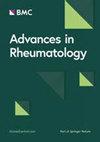脊柱关节炎的骶髂关节和脊柱成像:表型或性别重要吗?
IF 2.1
4区 医学
Q3 RHEUMATOLOGY
引用次数: 0
摘要
脊柱关节炎(Spondyloarthritis,SPA)包括一系列免疫介导的炎症,主要影响轴性骨骼,其中包括骶髂关节炎和脊柱炎,这两种炎症各有特点。本研究旨在调查不同表型以及男性和女性轴性SpA患者的成像差异,重点是骶髂磁共振和脊柱放射摄影。研究人员进行了一项横断面研究,评估临床数据、实验室检查结果、使用加拿大脊柱关节炎研究联合会(SPARCC)和骶髂关节结构评分(SSS)对骶髂关节进行的磁共振成像(MRI)评分,以及使用改良斯托克强直性脊柱炎脊柱评分(mSASSS)进行的颈椎和腰椎X光片检查。研究旨在比较两组患者的这些参数:轴性脊柱关节炎(axSpA,放射和非放射)和轴性银屑病关节炎(axPsA),以及男性和女性患者的这些参数。该研究共纳入了 94 名患者,其中 AxSpA 组 62 人,axPsA 组 32 人。两种表型的患者在疾病活动度、活动能力、脊柱放射损伤(改良斯托克强直性脊柱炎脊柱评分- mSASSS)或骶髂磁共振成像(MRI)评分(加拿大脊柱关节炎研究联盟磁共振成像指数- SPARCC 和骶髂关节结构评分- SSS)方面没有差异。就性别而言,在影像学检查中,男性的mSASSS(p = 0.008)、SSS(p = 0.001)和基于SSS的脂肪变性(MG)评分更高(p = 0.001),而女性的SPARCC评分明显更高(p = 0.039)。在男性组中,HLA-B27 等位基因的存在对 MRI(SSS)上更多的结构性病变有影响,p = 0.013。在这项研究中,轴性SpA患者的骶髂关节和脊柱成像并未显示出表型上的差异,但却显示出了性别上的差异,这可能会对未来的诊断建议产生影响。还需要进一步的研究来证实这些发现。本文章由计算机程序翻译,如有差异,请以英文原文为准。
Sacroiliac and spine imaging in spondyloarthritis: Does phenotype or sex matter?
Spondyloarthritis (SpA) encompasses a spectrum of immune-mediated inflammatory conditions primarily affecting the axial skeleton, including sacroiliitis and spondylitis, each with distinct features. This study aimed to investigate imaging disparities, focusing on sacroiliac magnetic resonance and spine radiography, across phenotypes and between males and females in axial SpA. A cross-sectional study was conducted to assess clinical data, laboratory findings, magnetic resonance imaging (MRI) scores of sacroiliac joints using the Spondyloarthritis Research Consortium of Canada (SPARCC) and Sacroiliac Joint Structural Score (SSS), and cervical and lumbar spine radiographs utilizing the Modified Stoke Ankylosing Spondylitis Spine Score (mSASSS). The study aimed to compare these parameters between two groups: axial spondyloarthritis (axSpA, radiographic and non-radiographic) and axial psoriatic arthritis (axPsA), as well as between males and females. Ninety-four patients were included, with 62 patients in the axSpA group and 32 patients in the axPsA group. There were no differences in disease activity, mobility, radiographic damage in the spine (Modified Stoke Ankylosing Spondylitis Spine Score– mSASSS), or sacroiliac magnetic resonance imaging (MRI) scores (Spondyloarthritis Research Consortium of Canada Magnetic Resonance Imaging Index - SPARCC and Sacroiliac Joint Structural Score - SSS) between the two phenotypes. Regarding sex, in imaging exams, men had higher mSASSS (p = 0.008), SSS (p = 0.001), and fat metaplasia (MG) score based on SSS (p = 0.001), while women had significantly higher SPARCC scores (p = 0.039). In the male group, the presence of HLA-B27 allele had an impact on more structural lesions on MRI (SSS), p = 0.013. In this study, imaging of sacroiliac joints and spine in patients with axial SpA did not show differences in phenotypes but did reveal differences based on sex, which may have an impact on future diagnostic recommendations. Further studies are needed to confirm these findings.
求助全文
通过发布文献求助,成功后即可免费获取论文全文。
去求助
来源期刊

Advances in Rheumatology
Medicine-Rheumatology
CiteScore
4.00
自引率
4.30%
发文量
41
审稿时长
53 weeks
期刊介绍:
Formerly named Revista Brasileira de Reumatologia, the journal is celebrating its 60th year of publication.
Advances in Rheumatology is an international, open access journal publishing pre-clinical, translational and clinical studies on all aspects of paediatric and adult rheumatic diseases, including degenerative, inflammatory and autoimmune conditions. The journal is the official publication of the Brazilian Society of Rheumatology and welcomes original research (including systematic reviews and meta-analyses), literature reviews, guidelines and letters arising from published material.
 求助内容:
求助内容: 应助结果提醒方式:
应助结果提醒方式:


